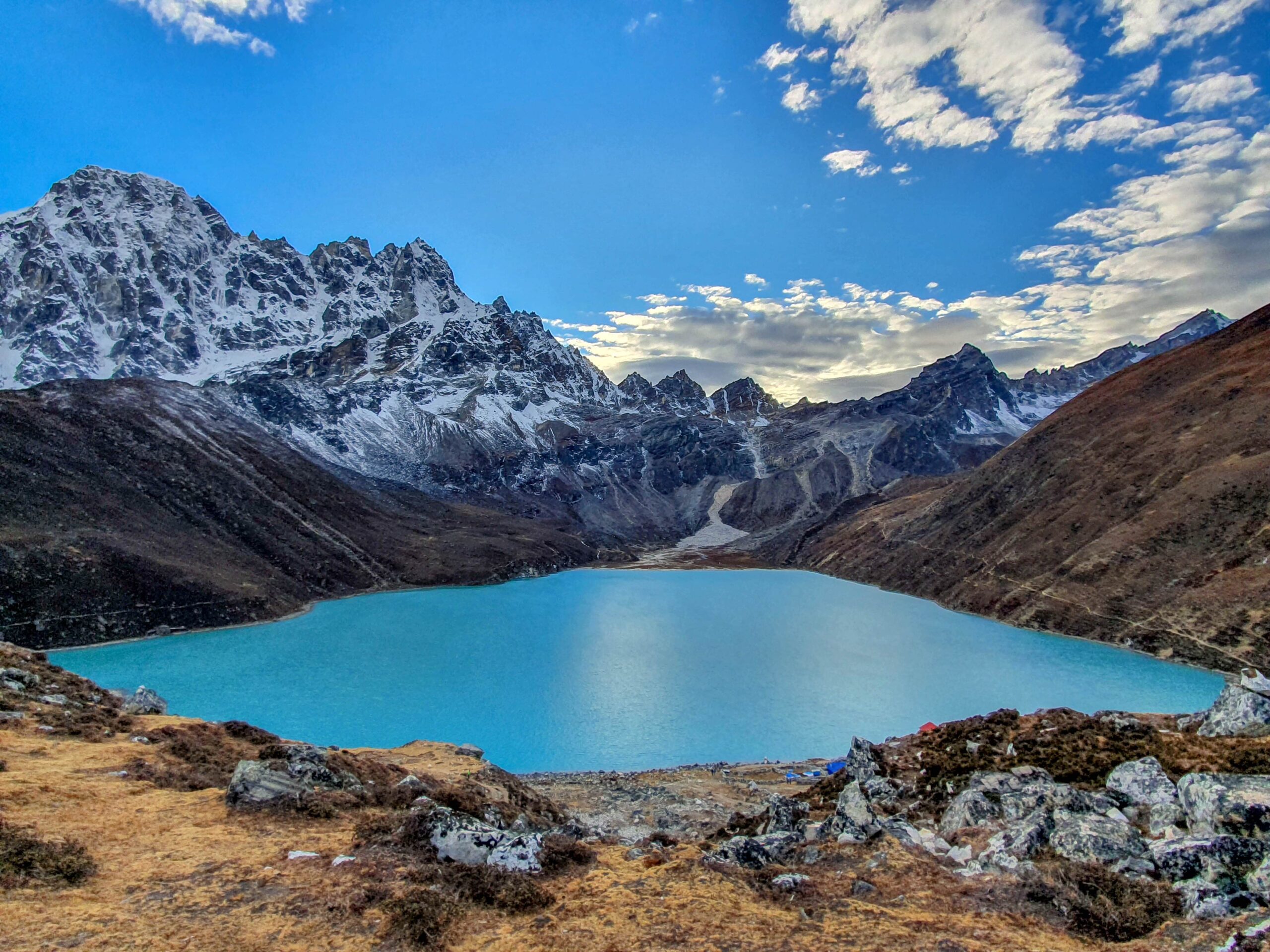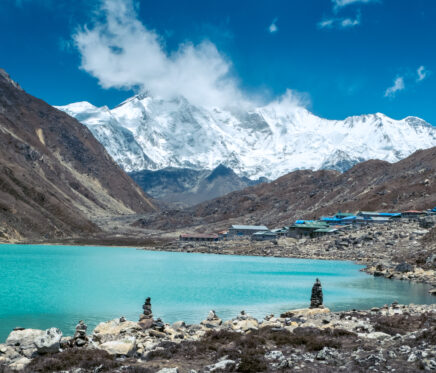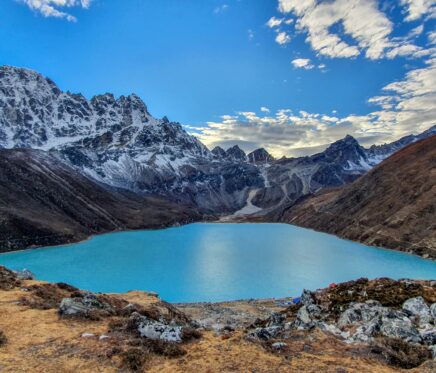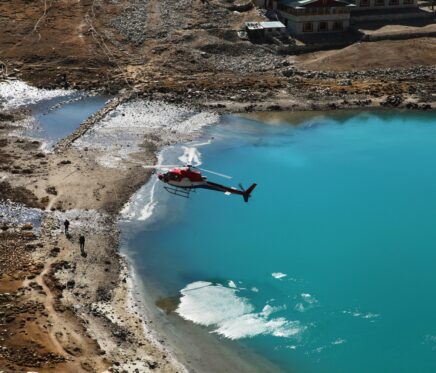Trip Overview
Everest Base Camp Trek via Gokyo & Cho La Pass
The Everest Base Camp Trek via Gokyo Lakes and Cho La Pass is one of the most rewarding and adventurous trekking routes in Nepal. Perfect for seasoned hikers, this trail combines the classic journey to Everest Base Camp with the added beauty of the Gokyo Valley, the challenge of Cho La Pass, and the panoramic summit views from Gokyo Ri.
Unlike the standard EBC trek, this itinerary ventures into less-traveled terrain, offering a quieter, more immersive experience of the Khumbu region. Along the way, trekkers enjoy breathtaking Himalayan landscapes, vibrant Sherpa culture, and unforgettable encounters with some of the tallest peaks on Earth — including Everest, Lhotse, Nuptse, Makalu, Ama Dablam, and Cho Oyu.
Why Choose the Gokyo Lakes & Cho La Pass Trek?
Gokyo Valley & Gokyo Lakes
The highlight of this route is the enchanting Gokyo Valley, home to six turquoise, glacial-fed lakes that shimmer against a backdrop of snow-capped peaks. Considered sacred by both Hindus and Buddhists, these lakes provide a peaceful and spiritual trekking experience far away from the busy EBC trail.
Gokyo Ri (5,357m)
From the summit of Gokyo Ri, trekkers witness one of the most spectacular panoramas in the Himalayas. The viewpoint offers clear 360° vistas of four of the world’s highest mountains — Everest, Lhotse, Makalu, and Cho Oyu — along with the entire Gokyo Valley below. For many, sunrise at Gokyo Ri is the single most memorable moment of their trek.
Cho La Pass (5,420m)
Crossing Cho La Pass is a thrilling and challenging part of the trek. This high mountain pass connects Gokyo Valley to the Everest Base Camp trail, requiring trekkers to ascend steep ridges and cross icy glaciers. The effort is rewarded with dramatic views and the sense of conquering one of the region’s toughest natural barriers.
Highlights of the Trek
-
Discover the world-famous Everest Base Camp (5,364m).
-
Marvel at the pristine Gokyo Lakes and explore the secluded Gokyo Valley.
-
Climb Gokyo Ri for unparalleled views of Everest, Lhotse, Makalu, and Cho Oyu.
-
Cross the adventurous Cho La Pass, one of the most exhilarating challenges in the Khumbu.
-
Ascend Kala Patthar (5,545m) for a close-up view of Everest and the Khumbu Icefall.
-
Immerse yourself in Sherpa culture with visits to traditional villages and monasteries.
-
Explore Namche Bazaar, the lively gateway to the Everest region.
Challenges and Distractions Along the Trail
Like any high-altitude trek, the Everest Base Camp via Gokyo Lakes and Cho La Pass route comes with challenges that trekkers must prepare for:
-
Altitude Sickness: Acclimatization is critical as elevations regularly exceed 4,500 meters.
-
Demanding Terrain: Trails range from rocky ridges to icy glacier crossings, particularly near Cho La Pass.
-
Unpredictable Weather: Sudden snow, wind, or cloud cover can temporarily hide mountain views.
-
Basic Facilities: Higher-altitude teahouses offer modest amenities, and internet or phone connectivity is limited.
-
Seasonal Crowds: While Gokyo Valley is quieter, sections of the EBC trail can still feel busy during peak trekking months.
Despite these distractions, each challenge contributes to the adventure, making the final arrival at Everest Base Camp all the more rewarding.
Why Trek with Mission Nepal Holidays?
Choosing the right trekking company can make or break your Himalayan adventure. At Mission Nepal Holidays, we go above and beyond to ensure your Everest Base Camp via Gokyo Lakes and Cho La Pass trek is safe, enriching, and unforgettable.
Experienced Local Guides – Our Sherpa guides are certified, highly knowledgeable, and deeply connected to the Everest region.
Tailor-Made Itineraries – Whether you want a standard trek, a short EBC version, or an extended Gokyo Lakes route, we customize trips to match your fitness and preferences.
Focus on Safety – We prioritize acclimatization, carry proper medical kits, and monitor trekkers daily to minimize altitude-related risks.
Authentic Cultural Experience – Stay in locally run teahouses, interact with Sherpa communities, and visit ancient monasteries along the way.
Responsible Tourism – We are committed to eco-friendly practices and supporting local livelihoods in the Khumbu region.
With Mission Nepal Holidays, you don’t just trek — you experience the Himalayas with a trusted partner who cares about your journey as much as you do.







 Spring (March to May)
Spring (March to May)  Domestic Flight
Domestic Flight  Challenging
Challenging  5364m
5364m  18 Days
18 Days
 Trekking
Trekking 





